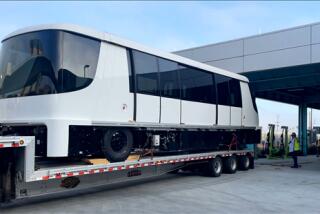Gearboxes Failing at High Rate on Blue Line Cars : Transportation: Cash-strapped MTA is forced to pay for repairs. Agency officials say they are talking to the contractor, Sumitomo Corp., in attempt to share the burden.
- Share via
Less than one-fifth of the way into their expected life spans, more than 15% of the gearboxes on Metro Blue Line cars have failed, forcing the cash-strapped Metropolitan Transportation Authority to buy new parts and overhaul equipment, officials said Tuesday.
Of 230 gearboxes, 38 have broken down much sooner than expected--some of them after only 48,000 miles of service. That is less than 5% of the 1-million-mile standard specified in MTA’s contract with the car manufacturer, Sumitomo Corp. of America.
For all but three of the failed gearboxes, the two-year warranty period had expired, forcing the MTA to dip into its coffers to fund repairs and maintenance.
However, Art Leahy, the agency’s executive director of operations, said discussions are under way with Sumitomo to mitigate the costs of fixing and maintaining the equipment, estimated at $750,000 initially and $350,000 a year thereafter.
“We’ll be exploring all the options,” said Leahy, who added that service has not been affected along the 22-mile Blue Line route between Long Beach and Los Angeles. “We are working with Sumitomo and discussing with them the engineering required to figure out what the ultimate solutions of this will be.”
Detection of the failures, made while the cars were out of service for routine inspections, is a blow to the transit agency, which is struggling to close a projected $126-million operating shortfall for the next fiscal year.
The faulty equipment also raises questions about the 15 cars Sumitomo has been selected to provide for the Green Line, scheduled to open next year. That contract was awarded in 1992 by the Los Angeles County Transportation Commission (now part of the MTA) before any widespread problem with the gearboxes had come to light--only seven had failed by that point, MTA chief spokesman Jim Smart said.
The 15 cars are in production. Sumitomo and the MTA are discussing whether a different gearbox system can be installed and an extended warranty granted, officials said.
“We are reviewing all factors involved in this matter,” said Sumitomo product manager Chuck White from Tokyo, where he said company executives and MTA officials were meeting to examine the problem and devise a solution. “I don’t want to speculate any more than that at this time.”
He declined to comment on what the company’s legal and contractual obligations are, saying only: “We’re responsive and responsible vendors.”
The 54 Blue Line cars were purchased in 1987 at $1.3 million apiece--along with some spare parts--and put into use in 1990. Inspectors discovered the first gearbox failure in June, 1991, and the problem has worsened over time. Stress has fractured the teeth in the gears that drive the wheel axles, officials said.
Each car has four gearboxes, which were manufactured by the Flender Corp. in Illinois. It was unclear how many cars are affected, but “enough of a problem has in fact occurred that it’s a serious issue,” Leahy said.
MTA officials added that future rail car purchases call for a different gearbox design that is expected to be more durable.
In December, 1991, the LACTC commissioned Sumitomo to manufacture the entire 41-car Green Line fleet, but a political uproar over awarding the contract to a Japanese-owned company forced officials to cancel the order.
Eleven months later, officials said time constraints left them no choice but to request 15 cars at $2.9 million each. Though the cars are virtually identical to their Blue Line counterparts, they cost twice as much because of the limited size of the order and the short time within which it had to be filled.
More to Read
Sign up for Essential California
The most important California stories and recommendations in your inbox every morning.
You may occasionally receive promotional content from the Los Angeles Times.














